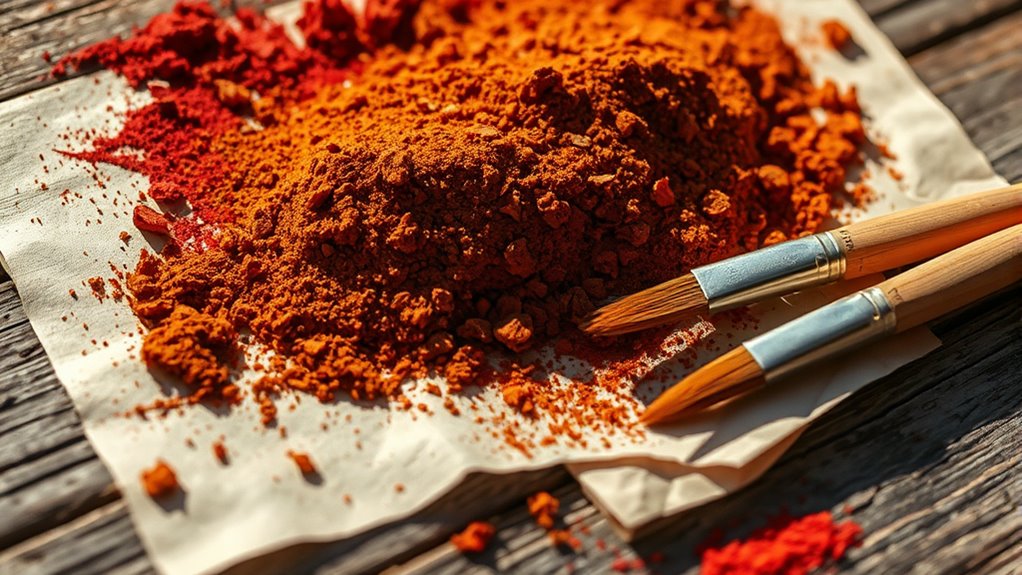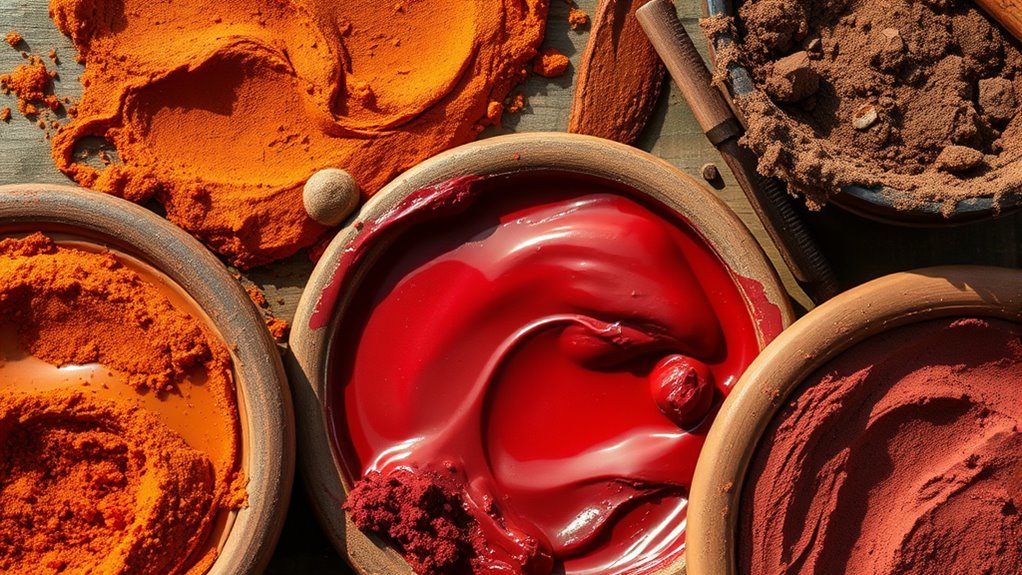Natural pigments let you craft vibrant art with earth-friendly colors that have rich historical and cultural roots. You can use plant-based, mineral, or insect-derived dyes to create sustainable, authentic works that connect you to centuries of tradition. These pigments offer deep, unique hues that improve over time, supporting eco-conscious practices. If you explore further, you’ll discover how innovative techniques and resources make natural pigments a versatile choice for modern creativity.
Key Takeaways
- Natural pigments are derived from plants, minerals, and insects, offering eco-friendly alternatives to synthetic dyes.
- They have historical significance, used in ancient art, textiles, and cosmetics, reflecting cultural and spiritual values.
- Modern artists favor natural pigments for their sustainability, unique richness, and connection to traditional craftsmanship.
- Techniques for extraction and formulation enhance pigment stability, vibrancy, and longevity in various creative applications.
- Using earth-friendly colors supports environmental health and promotes sustainable practices in contemporary art and design.

Have you ever wondered what gives fruits, vegetables, and flowers their vibrant colors? It’s all thanks to natural pigments—powerful compounds that have fascinated humans for centuries. Throughout history, these pigments have played a significant role in art, tradition, and even medicine. Ancient civilizations, like the Egyptians and Chinese, used plant-based dyes to color textiles, manuscripts, and cosmetics. They valued these colors not only for their beauty but also for their cultural and spiritual significance. For example, indigo dye, derived from the Indigofera plant, was highly prized in trade and became a symbol of royalty and prestige in many societies. Similarly, the bright reds from madder root and the yellows from turmeric found their way into paintings and fabric dyes, demonstrating how natural pigments were integral to daily life and craftsmanship.
Today, the use of natural pigments extends beyond traditional applications. Modern artists and designers are increasingly embracing these earth-friendly colors as sustainable alternatives to synthetic dyes, which often contain harmful chemicals. Natural pigments are derived from a wide variety of plants, minerals, and even some insects, making them versatile and eco-conscious options. Innovations in extraction and formulation techniques have made these pigments more stable and vibrant, suitable for everything from watercolor paints to textile dyes. You can find natural pigments in products like eco-friendly cosmetics, food coloring, and even in architecture, where they add color to sustainable building materials. Their popularity continues to grow as consumers and creators seek ways to reduce environmental impact without sacrificing beauty or quality.
Using natural pigments isn’t just about sustainability; it’s about reconnecting with nature’s artistry. When you choose these earth-derived colors, you’re supporting a tradition that dates back thousands of years but also contributing to a healthier planet. Whether you’re an artist looking for unique hues or a DIY enthusiast exploring eco-friendly crafts, natural pigments offer a broad palette that’s rich in history and full of potential for contemporary use. They bring a depth and authenticity to your work that synthetic colors sometimes lack, making your creations not only beautiful but also meaningful. From ancient trade routes to modern sustainable art projects, natural pigments continue to serve as a bridge between the past and the present—proof that Mother Nature’s colors can be just as vibrant and enduring as any synthetic alternative. Additionally, understanding the extraction techniques used can help artisans optimize the vibrancy and longevity of their colors.
Frequently Asked Questions
How Long Do Natural Pigments Typically Last in Artworks?
Natural pigments typically last decades in artworks, but their durability varies based on factors like exposure to sunlight, humidity, and handling. You should consider fading factors such as UV light and environmental conditions, which can weaken pigment color over time. By protecting your art with proper framing, avoiding direct sunlight, and controlling humidity, you can enhance pigment durability and guarantee your earth-friendly colors stay vibrant for many years.
Are Natural Pigments More Expensive Than Synthetic Alternatives?
You might find natural pigments more expensive than synthetic ones, especially if you consider a hypothetical artist using rare earth minerals that cost more upfront. The cost comparison varies, but natural pigments often have a higher initial price due to sourcing and processing. However, they offer a lower environmental impact, making them a sustainable choice. Over time, their eco-friendly benefits can outweigh the higher initial expense, especially for environmentally conscious artists.
Can Natural Pigments Be Used on All Types of Surfaces?
Yes, natural pigments can be used on many surfaces, but their surface compatibility varies. You need to take into account the specific surface and use proper application techniques to ensure good adhesion and durability. For example, natural pigments work well on paper, wood, and fabric, but may require a suitable primer or binder for surfaces like metal or plastic. Always test first to achieve the best results with your chosen medium.
How Should Natural Pigments Be Stored to Maintain Their Vibrancy?
Think of natural pigments as precious gems that need protection. To maintain their vibrancy, store them in airtight containers away from light, heat, and moisture—these are your best storage techniques. Keep pigments in a cool, dark place to prevent fading, and avoid frequent exposure to air. Proper pigment preservation ensures your earthy hues stay lively, turning your art into a lasting masterpiece.
Are There Health Risks Associated With Handling Natural Pigments?
Handling natural pigments isn’t usually risky if you follow handling precautions, but pigment toxicity can vary. Some pigments contain harmful substances, so wear gloves and a mask to avoid inhaling dust or skin contact. Always research specific pigments and their toxicity levels before use. If you notice irritation or allergic reactions, stop handling immediately and seek medical advice. Taking these precautions keeps your art practice safe and enjoyable.
Conclusion
By choosing natural pigments, you embrace a sustainable, earth-friendly way to create art that’s timeless—much like the great masters of the Renaissance. These colors connect you to centuries of tradition, proving that beauty doesn’t have to come at the planet’s expense. So, next time you paint, remember: with natural pigments, you’re not just making art, you’re preserving the earth’s palette for future generations—no need to wait for a time machine to see the difference.








